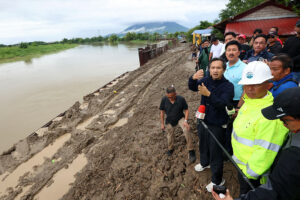Chances are that many of us who start the morning with news and check updates throughout the day even as we carry out other tasks have experienced by now some degree of fatigue from the seemingly bottomless pit of how public officials steal our hard-earned money.
As with Bangko Sentral Governor Eli M. Remolona, Jr. and Public Works Secretary Vince B. Dizon (who seems to have aged decades overnight since he began inspecting flood control projects in early-September), we knew the graft and corruption in infrastructure was bad — but we did not know it was this bad.
There was a time when economists would assure us that investors would still come in despite corruption (which afflicts all countries to varied degrees anyway), so long as the manner it was practiced was predictable. But the weekly emergence of ever-new details of wanton plunder of public funds has lately started to weigh on the stock market and the peso, showing that business confidence has begun to take a hit.
It certainly did not help that even counterpart funding for some foreign-assisted projects had reportedly been moved to unprogrammed (uncommitted, conditional) funds in this year’s national budget, raising eyebrows in the foreign aid community (one can only imagine what they thought: we earmarked our people’s money for your benefit and you did even not reciprocate by showing a similar commitment.) The utter stupidity which greed breeds can still astound us today after all.
The central bank’s latest quarterly business confidence survey shows the “current quarter” reading of 23.2% for third quarter 2025 being the weakest in four years. This reading was registered in a survey that ran from July 4 to Aug. 17 (President Ferdinand Marcos, Jr. delivered his State of the Nation Address, or SONA, that zeroed in on flood control irregularities on July 28). To be sure, the central bank blamed dampened demand during the “ghost month,” the onset of rains and storms, as well as global headwinds like higher US tariffs, geopolitical mentions, and weaker foreign demand for the latest reading. Interestingly, the same survey round showed the “next quarter” confidence reading rising to a four-quarter-high 49.5%.1
A parallel central bank survey conducted on July 1-12 (or before the SONA) showed consumers — who have always been downbeat for the “current quarter” since at least 2021 — at their least pessimistic in the third quarter at -9.8% since April-June 2024. Respondents turned more optimistic for the “next quarter” (6.9%) and “next 12 months” (14.1%).2
It will be interesting to see how these readings will fare as 2025 draws to a close.
‘HEIGHTENED RISK’As I write this column, the Asian Development Bank (ADB) also released its latest macroeconomic projections in the September 2025 issue of its Asian Development Outlook (ADO). The September ADO shows the gross domestic product (GDP) growth projection for the Philippines kept at 5.6% for this year from July, though down from the 6% expectation in April, but slashed further to 5.7% for 2026 from 5.8% in July and from 6.1% in April. The Philippines will outpace a downgraded 4.3% for Southeast Asia for this year and next, as well as 4.8% (2025) and 4.5% (2026) for “Developing Asia” (composed of 46 economies in Asia and the Pacific).3
Multilateral lenders (including the International Monetary Fund and the World Bank besides), international financial surveillance institutions (like the ASEAN+3 Macroeconomic Research Office), private banks, and think tanks have been tempering growth expectations for the Philippines and much of the world in the face of nagging uncertainties caused by an intensifying trade war between the US and its traditional trade partners and China, as well as geopolitical tensions in Europe and the Middle East.
“The growth outlook remains strong at 5.6% for 2025 and 5.7% for 2026, although both are slightly below ADO April 2025 forecasts. External headwinds and heightened uncertainty over global economic policies have weighed down trade and investment prospects,” the latest ADO read in part. “Amid these challenges, however, low inflation and monetary easing are expected to sustain domestic demand, with overall inflation likely to ease more in 2025 than earlier projected.”
Speaking to journalists in a press conference, ADB Country Director for the Philippines Andrew Jeffries said that recent and ongoing revelations on the extent of corruption all the way to the highest levels of government present “certainly a heightened risk,” adding that “[b]etween now and the December update, there may be more quantifiable data available that may alter our projections [further].”4
“Corruption has broad impacts on economic growth in general and investment sentiment. So, we’re monitoring that, and how that may be affected going forward.”
NOT STRONG ENOUGHPhilippine state economic managers forming the Development Budget Coordination Committee now project GDP to grow by 5.5% to 6.5% this year and by 6-7% annually from 2026 to 2028, after cutting these targets in a late-June meeting from 6-8% as of December 2024.
Those numbers seem relatively “strong” compared to many other Asian economies, but there is one problem: both state and private sector economists have flagged a relatively high poverty rate as a key weakness of the Philippines, meaning growth has not benefitted most of our population. After all: what use is fast expansion of economic activity if it does not improve the lives of most Filipinos and benefits only the super-rich? Hence, the government’s focus on achieving inclusive economic growth.
The thing is: for GDP expansion to be inclusive, it needs to be sustained at a faster clip first. Economists like Dr. Bernardo M. Villegas and former Finance secretary Margarito B. Teves believe that it will take no less than sustained 8% annual growth “to bring us to single-digit poverty incidence by 2028”5, as targeted by this administration.
Let’s be realistic: the only years in which we hit that pace were 1973 and 1976 — each at 8.8% — and we closed in with 7.3%, 7.1%, and 7.6% in 2010, 2016, and 2022; hence, not in any way sustained.6
And it’s not just the pace of overall economic growth, mind you. The fact that Metro Manila accounts for more than a third of the country’s economic activity — and that Central Luzon, the National Capital Region, and Calabarzon combined account for about 60% — shows just how skewed economic opportunities are towards these areas.7
Despite tempered growth expectations, the Department of Economy, Planning, and Development (DEPDev) said in the midterm update of the Philippine Development Plan 2023-2028 that was released more than two weeks after Mr. Marcos’s mid-term SONA that “[w]hile we lowered our growth targets, we remain optimistic about reducing poverty rates to single-digit levels by 2028.”
Specifically, the government hopes to reduce poverty incidence to 10-11% by 2027 and to 8-9% by the time Mr. Marcos ends his term in 2028, from an estimated 12-13% this year.
DEPDev had cited Philippine Statistics Authority (PSA) data showing that poverty incidence eased to 15.5% in 2023 (missing a 16-16.4% target for that year) from an estimated 18.1% in 2021.
For better, updated perspective from the ground, the June Social Weather Stations report shows nearly half of respondents rating themselves “poor.”8
PAINFUL, BUT NECESSARYSignificantly, the Department of Public Works and Highways (DPWH) has slashed its own proposed budget for 2026 by P255 billion, or nearly a third, to P625.78 billion, by removing funding for locally funded flood control projects.9
This was a painful, but necessary step in the face of the rot that has infected all corners of that department.
But it will nip at overall economic growth, since government spending — especially for infrastructure — is a key driver of such expansion (especially since completed infrastructure boosts production of various sectors). By how much — that certainly bears watching.
In its latest ADO, the ADB noted that “[p]ublic investment remains a steady growth driver across the subregion. In the Philippines, the government targets infrastructure spending to be 5-6% of GDP, encompassing major projects in transportation, railways, bridges, and the Metro Manila subway… Sustained public infrastructure investment will… continue to boost growth.”
Well, the problem is: the first half of this year already saw overall infrastructure and capital outlays merely edge up by 1.4% to P620.2 billion, missing a P621-billion program. And, as expected, state infrastructure spending dropped by a fourth annually to P93.3 billion in July as the DPWH withheld disbursements.10
And if we were to believe the claims made by a DPWH official in a recent Senate hearing: the problem that hounds flood control projects afflicts other infrastructure as well, including roads, bridges, and classrooms.
All these considerations leave us with a sinking feeling that overall economic growth projections, as well as expectations that poverty incidence will decrease, will have to be tempered further. It’s just a matter of time. How’s that for political optics these days?
The other way of looking at this situation is: do we now wonder why inclusive growth has been just so very elusive for us? Nominal increases in already muted state spending each year are useless, if quality is not served by making sure that allocated moneys go to target sectors/beneficiaries, and not to the pockets of a few (who are wont to spend our hard-earned cash abroad anyway, with no benefit to our country).
WHAT NOW?Well, here we are, and we might as well take this to the hilt.
There is, of course, the question of how far the government can sustain and expand its current anti-corruption drive. Just the magnitude of flood-control projects alone seems so daunting, never mind bridges, roads, classrooms, etc.
Already, there have been allegations that the current campaign has been more focused on government critics, sparing those close to Malacañang. That’s the kind of impression the government can ill afford to have this early in the game, if its campaign is to succeed.
Civil society should not drop the ball after the Sept. 21 rallies, and should find ways to coordinate efforts and present a cohesive front to pressure the government to press on, and to redirect efforts, if needed. Piecemeal advocacies will fall on deaf ears, for sure.
Faced with current realities, government departments and agencies at the forefront of serving the poor need to review current programs not only to meet their daily needs, but also to empower them with livelihood skills.
At this point, I recall again a September 2023 study by the non-profit July Homes Foundation and Association Soeur Emmanuelle Philippines, Inc., which cited PSA estimates that there were 4.5 million homeless individuals in the Philippines — including about 250,000 children, many of them engaged in begging, peddling, and jeepney “barking” — as of 2018, about two-thirds of them in Metro Manila.
That’s a whole lot of these folks, whose ranks could grow if the economy fails them further.
For us mere mortals, ordinary citizens, there is a new mechanism set up recently by the archdiocese of Manila: the ministry for street dwellers.11 To be led by a Vincentian priest, Fr. Francisco Nicolas Magnaye, Jr., this new structure will focus on putting in place a multi-sectoral support system, compiling an inventory of resources for the homeless, pooling resources and efforts among service providers, and organizing at the parish and inter-parish levels.
Programs will include feeding, crisis intervention, psychosocial services, healthcare, legal services, as well as education, and skills and livelihood training. The same ministry will also train youth advocates and conduct relevant research.
The archdiocese said that the goal is to go beyond providing assistance, to building empowered communities that can transition beneficiaries away from street life.
Hopefully, this will be another new conduit for people’s activism amid current challenges: that even if the government were to fail or fall short, ordinary folks like us will not fail those left at the peripheries, whatever else happens.
1 https://tinyurl.com/26jxnl8a
2 https://tinyurl.com/2dm897l7
3 https://tinyurl.com/2b9ykz7l
4 https://tinyurl.com/2dkgqlf8
5https://www.https://tinyurl.com/24yxq2ca
6 https://tinyurl.com/268bubsz
7 https://tinyurl.com/2dnt73a2
8 https://tinyurl.com/25evel5t
9 https://tinyurl.com/27lbh24p
10 https://tinyurl.com/2bsbmeyw
11 https://tinyurl.com/24bsel72
Wilfredo G. Reyes was editor-in-chief of BusinessWorld from 2020 through 2023.

